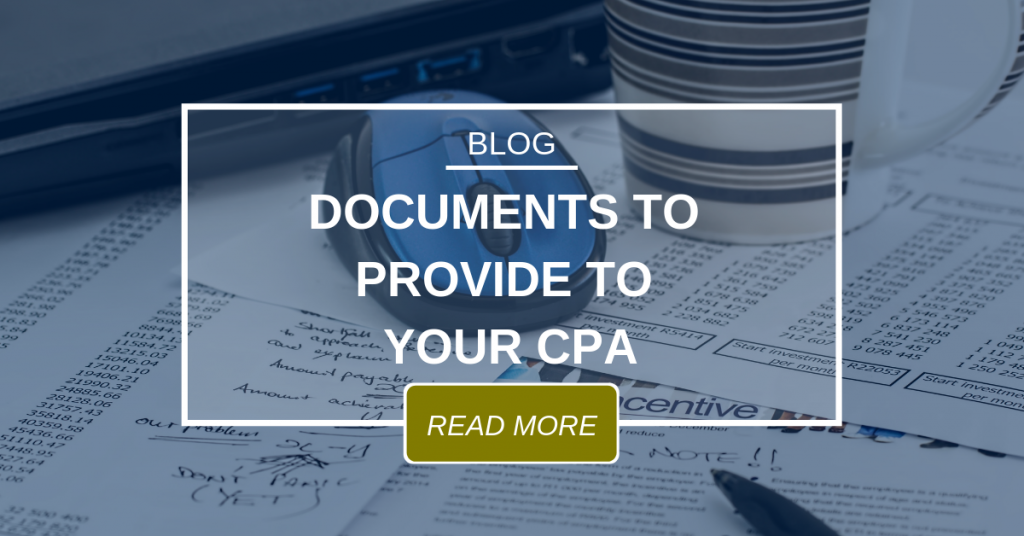It’s officially tax season
— that time of year our friendly neighborhood CPAs begin hibernating in their offices… and the time you need to provide documents to your CPA. As with a typical grizzly, it’s important not to needlessly poke the bear. Let’s review the key information your CPA will be looking for and make a commitment (to them) to provide that information before April 14th.
- W2s: If you’re employed, your employer should have provided your W2 by January 31. If not, you have full permission to kick and scream and demand that information.
- 1099R: If you took money out of an IRA in 2018, you should have received a 1099R by February 1. Note: If you’re over age 70 ½ and gave money to charity directly from your IRA, it is your responsibility to tell your CPA the amount of the charitable gifts. (You should also have an acknowledgement letter from the charity for all gifts of $250 in total or more made during the year.) Although you would think this information would appear on the 1099R, it does not. The CPA has no way of knowing you made charitable bequests via your IRA, so the responsibility is on your shoulders. Before you blame your favorite financial planner for not telling your CPA, remember – it’s your responsibility.
- 1099: If you have an investment or bank account that is not a retirement account, you will get a 1099 detailing your interest, dividends and capital gains. This form should be available by February 15 at the various institutions.
- K1s: If you have an investment in real estate, a business or a partnership, you should receive a K1 Form by March 15.
- Property Tax Bill: If you paid property taxes in 2018, provide a copy of your tax bill along with receipts documenting when it was paid.
- Social Security Statement: If you or your spouse is receiving Social Security, you should have received an SSA-1099 in the mail by January 31.
- Medical Expenses: If you have qualified medical expenses that think exceed 7.5% of your adjusted gross income, provide your CPA with the amount of medical expenses paid for in 2018.
- Mortgage Interest: If you have a mortgage, your mortgage provider will send Form 1098 documenting the amount of the interest paid in 2018. That form is usually available no later than February 15.
- College Costs and 529 Plans: If you pay for college expenses via a 529 plan, the 529 provider will supply Form 1099-Q, documenting the amount of your withdrawals. This form is usually available by February 15. The University will supply Form 1098-T documenting the amount of tuition, less scholarships and other adjustments paid in 2018. This form is typically available by February 1.
Electronic Format
In the day and age of electronic records, if you’re holding your breath and waiting for forms to arrive in the mail, you’ll likely turn purple. Many of these documents are likely waiting for you in electronic format at your custodian or plan provider. Login and begin looking. As this is a once a year process, it may take a little time to find each document on the various websites. A password manager, like LastPass, is an incredible tool to expedite this process. The password manager can store your login credentials for quick retrieval; and you can also make notes for each provider that will help you find the documents faster next year.
Standard Deduction
As the standard deduction doubled from 2017 to 2018, only 10% of the population will continue to itemize deductions. It may be worth a phone call to your CPA to discuss your current deductions. If your total itemized deductions will be nowhere close to the standard deduction limit, he may tell you to simply skip that part of the process. Note: Your tax preparer may still need your itemized deductions to calculate your state income tax return. Not all states have adopted the federal provisions for tax calculation. So do not discard your tax documents – provide them to your accountant just in case.
Procrastination
In years past, many people were rewarded for procrastinating in providing their tax documents because providers were either late in generating their tax forms or the tax forms would change weeks after their original release. Both issues have been improving the last several years, and it’s likely you will have all necessary forms at your disposal by the time you read this blog. Don’t delay! Spend 1-2 hours this weekend assembling the necessary documents and get them to your tax preparer. Set a goal of getting all necessary forms to your CPA by March 1 at the latest. Even if a form for your K1 investment hasn’t arrived, the CPA can complete 95% of your return and finish it when the last document or two arrives.
A little secret about CPAs
Lest you take your CPA for granted, you should know there is a growing shortage of CPAs in the country. When coupled with the increased complexity in the tax code, CPAs are busier than ever. Many CPAs pick and choose their clients based on several factors, one of which is ease of working with you! If you show up on April 10th with your documents demanding your return be completed by April 15, the CPA will either file an extension and deal with you later; or they may simply refer you to their colleague down the street and never deal with you again.
So… what are you waiting for?



